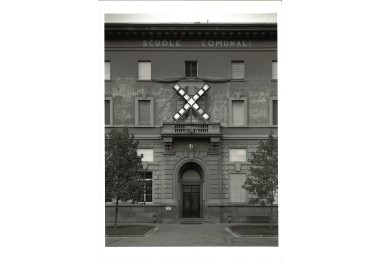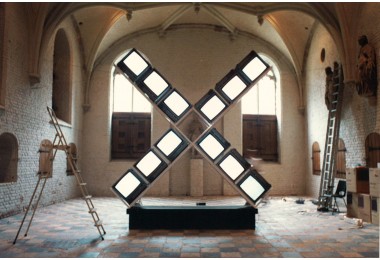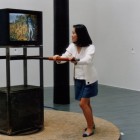-
Next >
The Research Agenda 2008-2012 includes five research programmes focussing on collection-management. Their binding factor is ‘valuation’.

-
Program
Value and valuation
Development of methods and techniques to objectify the value and appreciation of cultural heritage.
more info >Under 'valuation' in relation to heritage we mean making substantiated and verifiable statements about the value of an object or a collection, based on a question falling under an appropriate frame of reference and concerning certain stakeholders. Predetermined and predefined criteria are applied.
This explicit defining of an assigned value is necessary to steer preservation, development and utilisation and to enable a societal basis for heritage to emerge. After all, who determines the value of the collection now that the 'expert' no longer counts as the sole authority? How do you valuate an object or collection if there is no objective measurable value? How do you provide sufficient societal support for heritage at a time when the cultural sector is under pressure?
Awareness
The Value and Valuation programme aimed to make the various players in the heritage field (owners, managers, policy makers and funders) aware of the importance of the intrinsic (non-financial) value and valuation of cultural heritage, and to develop methods and techniques to attribute value to objects and collections. As valuation benefits from a broad interdisciplinary approach, the emphasis lay on dialogue and collaboration with external partners. A new system was developed in close consultation with the museum world to facilitate the process of value attribution. This has resulted in the publication of On the museum scales: collection valuation in six steps.
Independent valuation
This practical guide takes the user through the valuation process step-by-step and results in a description of object/collection significance, a valuation ranking or grouping, or an investment plan. With well-founded arguments it is possible to explain to others the value of an object or collection and the reasons for the value. This facilitates decision-making on interventions, making conflicting interests negotiable and making stories behind the collection accessible.
-
Program
Collection Accessibility
Research into the effectiveness of methods and means to make heritage and related knowledge accessible online.
more info >New media forms a tempting alternative to traditional analogue guides for the public as staff and resources in museums are generally scarce. But do they function as well or better than gallery texts, guided or audio tours?
Are some applications more effective than others? Are there any applications that actually generate more visitors, and if so, which?
Effectiveness
The Accessibility programme focused on the effectiveness of virtual resources to make heritage visible and to interest new types of public. Possibilities include apps, 3D and AR techniques, and also social media like Facebook and YouTube. But what to choose from the overwhelming number of new techniques?
Insight
The RCE carried out an inventory to provide collection managers with an understanding of the developments and possibilities of new media (and the institutions that can assist in developing applications). This also aimed to chart the applications most effective for specific objectives for both content and generating visitors. The projects on which these questions were tested were diverse in nature:
- Conservation of two textile objects of polypropylene. In this project, the practical applicability of conservation knowledge about polypropylene was tested. In addition a conservation treatment of polypropylene was recorded for educational objectives and the conservation file placed online. As a result, both the object and the information are permanently accessible for consultation by collection managers and conservators.
- Imago revisited: research into two installations in a case study using good practice (developed during the Inside Installations project) regarding the daily and long-term management of complex (multimedia) installations.
- Generating and sharing knowledge online about the conservation of contemporary art in the two-year European project PRACTICs by museums, institutes and universities. Associated with this was a public testing of the film Installation Art: Who Cares? as an educational tool, to investigate how much visitors appreciated having a look 'behind the scenes'.
- CARTA project, an inventory of documentation projects and documentation systems with which research findings are linked to locations and artworks.
- Inventory of the operation of two thematic networks (INCCA Education and Postdoc Network) under INCCA.
- Archiving the website with all details of the Inside Installations project, the preservation and presentation of Installation Art Project (2004-2007), a research into the re-installation and documentation of 33 complex multimedia installations.
- Participation of the RCE as a research partner in the pilot project of MuseumApp, under which the effectiveness of this app for heritage institutions was studied.
- Development of guidelines to increase the effectiveness of museum institutions online.
-

-
Project
Development of the website 'From Research to Restoration' (R2R) intended to help prevent the rapid degradation of polypropylene objects.

-
Project
Evaluation of the function of two thematic networks under the INCCA platform.

-
Project
Improving guidelines for the re-installation and long-term preservation of multimedia art.
Reading modeshareIn the 1990s an exhibition of Dutch media art travelled all over the world: Imago, fin de siècle in Dutch contemporary art. The re-installation of two installations from this exhibition, Panta Rhei by Ricardo Füglistahler and Mill x Molen by Bert Schutter, gave cause to improve guidelines and protocols and carry out digitalisation for greater accessibility.

Imago-exhibition in Amsterdam in 2009. In the background the work Mill x Molen of Bert Schutter'.
Multimedia installations go out-of-date at lightning speed due to on-going technical progress. Hence this kind of art demands special attention in the field of management and conservation. In practice the re-installation or conservation of video art for example, often means 'migration' in which the video signal is transferred to a carrier that is compatible with today's state-of-the-art hardware so that the signal is readable for current viewers.
Re-installation
In the period 2002-2006, three video installations from the Imago exhibition were re-installed, conserved and documented: A Virus of Sadness by Lydia Schouten, Albert's Ark by Bill Spinhoven and Revolution by Jeffrey Shaw and Tjebbe van Tijen. The re-installation of Revolution and Albert's Ark took place as part of Inside Installations, an international collaborative project in which more than thirty similar case studies were conducted. Inside Installations led to the first guidelines for the management, conservation and documentation of installation art. However, these guidelines were not yet widely applicable and accessible for collection managers.
Guidelines and protocols
The Imago Revisited project changed the situation. The ICN (now RCE) and the NIMk (now the Living Media Art Foundation, LIMA) aimed to test the guidelines developed during Inside Installations on two additional case studies. In addition the guidelines would be further developed into generally applicable protocols for the management and conservation of multimedia art. The choice of the case studies fell on the installations of Panta Rhei by Ricardo Füglistahler (1988) and Mill x Molen by Bert Schutter (1982), which were re-installed in the NIMK. The technology, functionality and significance of the works have been extensively researched and documented. Conservation was carried out in collaboration with the artists where necessary. The re-installation of these two works was intended not only to assess the existing guidelines from the previous Inside installations project but also to further develop them into generally applicable protocols that are accessible online and also applicable for similar multimedia works.
Conservation of Contemporary Art
Imago Revisited is associated with PRACTICs (Practices, Research, Access, Collaboration, Teaching In Conservation of Contemporary Art), a European project in which more than thirty museums and educational institutions collaborate on the conservation of contemporary art. The connection with Obsolete Equipment of PACKED and NIMk (conducted in collaboration with a number of Dutch and Belgian museums) was more specific. This project involves the digitisation and preservation of audio-visual artworks in the context of missing original playback equipment. The results of the Imago Revisited project are also published through the communication channels of these projects.
About Imago
The Imago exhibition was a co-production of ICN and Media Art Institute (forerunners of the RCE and LIMA, the Living Media Art Foundation). The exhibition displayed to a large public the different ways in which Dutch artists incorporate new technologies into their work. The exhibition, which consists of thirteen multimedia installations, was acquired by the ICN in its entirety in the late 1990s. The RCE now manages the objects and the LIMA the video material.
Publications
RCE, Besluitvormingsmodel DOCAM, 2013.
Links
Inside Installations (gearchiveerde website)
Projectmanager
Paulien 't Hoen
Team members
Evelyne Snijders, Gaby Wijers (LIMA, prev. NimK), Ramon Coelho (LIMA, prev. NimK).
We thank the artists Bert Schutter, Ricardo Fuglistahler and Paul Klomp (Klomp kunst en electro)
Partners
NimK (now LIMA)

-

-
Project
How to get in touch with a new online heritage audience - a guide.

-

-
Project
A guide for measuring the effectiveness of apps and websites.

-
Project
Generating and sharing knowledge about the conservation of contemporary art by museums, institutions and universities.

-
Project
Evaluation of the documentary Installation Art: Who Cares? as information medium.

-
Project
Inventory of documentation systems to link research results to locations on artworks.

-
Program
Object in context
Enrichment of the object in its context on the basis of technical art history and research, for the benefit of its conservation and restoration.
more info >Objects that have been handed down to us from the past can tell a story of their history of creation and how they have changed over time.
The Object in Context programme makes such stories accessible through research on the material object and its contextual clues (historical evidence). In addition, the program focuses on questions concerning the restoration and conservation of a range of objects, from classical antiquity to contemporary art, from paintings and textiles to metal and plastics.
CSI
Under Object in Context, analytical chemistry researchers and forensic specialists delve into cause and effect. Besides a keen eye for detail, they employ a research laboratory and technological methods that enable the visualization of evidence visible only at a molecular level. Although analytical research often forms the basis for research, collaboration with other disciplines, such as art and cultural history, is always sought as well.
Arts meets sciences
A connecting link between the many projects under Object in Context is the extent to which ageing is regarded as acceptable. That limit of acceptance is subjective and cannot be considered purely from the material-technical perspective. Thus the theme of 'perception of the surface' is key in several projects. This involves coupling the scientific 'looking' through apparatus with subjective, human visual perception.
Download here the comprehensive introduction to the Object in Context program, including an introduction to the projects in PDF.
-
Program
Museometry
Quantitative research on composition, use and policies concerning museum collections.
more info >In the museum sector, procedures and processes of collection management are analysed using figures and indicators to only a limited extent. As a result, decisions are often based on impressions or tradition.
Ad hoc quantitative analyses have been performed in recent years. Again and again it has proved difficult to generate reliable figures.
Structural
When comparing museums it was also revealed that the number of variables arising form an almost insurmountable barrier for benchmarking. The RCE therefore opted for a structural, long-term program with the focus on a statistical approach to research questions concerning collection management.
EBM
Under the Museometry programme, quantitative research is conducted on the composition, use and exploitation of museum collections. Trends and developments are distilled from the collected facts and figures on museum collections (museometry). The resulting figures and analyses are made available for the museum professionals and managers responsible for museum collections. In turn, they use this quantitative data for the formulation of various policies concerning these collections. In this way museometry contributes to evidence-based management (EBM) in the museum sector.
Projects
Projects under this program include:
- The Loan Monitor: a website that visualises on a map loan movements between national and international museums for exhibitions.
- The Modern Art Collection Audit (CMBK), a statistical analysis of how Netherlands museums have collected modern art from 1999 to 2009. The database, comprising acquisition data from about 40 museums with relevant collections of modern art, makes statistically based statements possible about the collection policy of the museums.
- The 20th century Artist Index, in which major artists are inventoried from the period 1870 to the present.
- Completion and verification of available data on international collection mobility, accessibility and cultural participation arising from the implementation of the indemnity scheme.
- An inventory and analysis of museum annual reports.
-
Program
Collection Risk Management
A user-friendly method for heritage managers to assess and manage risks themselves.
more info >The Collection risk management (CRM) program is aimed at minimizing the loss of value at the interface between preservation and use. The existing CRM methodology has been tested in different situations, developed and simplified in order to bring it within reach of smaller institutions with limited time and resources.
To this end, new instruments were developed and information necessary to quantify the various risks was generated and made available in the convenient form of a digital manual. The program concluded with an international meeting on risk management.
CRM
Risk management examines all the threats to which collections are exposed and combines preventive conservation, security and facility management. This forms the next step in the professionalization of collection preservation and management. In applying this strategy, the risks for a collection are identified, analysed and evaluated. These risks can then be compared on the basis of the expected value loss over a given period (risk assessment) and ranged to set priorities for measures to reduce this loss of value. This aids the collection manager in making informed and substantiated choices in the deployment of the often limited resources available to collection management.
Methodology
Under the CRM program, the methodology was tested in case studies, courses and workshops, then further developed and simplified so that smaller institutions with limited time, resources and knowledge can also gain insight into their own situation. To this end knowledge must be generated to qualify or quantify the various risks and ultimately made available in a usable form. This process was carried out in a number of projects under the program. Knowledge development and deployment of the indemnity scheme also fell under this program. The field of security risks and calamities was covered in collaboration with the Safe Heritage programme.
Handbook
The before-mentioned knowledge and instruments are for the most part collated in the Digital Collection Risk Management Manual. This describes the methodology step-by-step, provides instruments for conducting a risk analysis and sets out the available information on the ten most important damage factors. In this way, the user is able to carry out a risk analysis with their team. The Manual helps in formulating the right questions for external experts.
Risk analysis
Two projects under the program were intended to generate data to aid in assessing risk scenarios and to determine extent of risk. On the one hand quantitative information was collected for events that could lead to loss of value (damage factors of fire, theft and vandalism, mechanical forces and water), and on the other, degradation processes (damage factors of climate, light, mechanical forces vibration and air pollution/dust). In addition, a model was developed under the Cost Effectiveness project for determining the cost-effectiveness of conservation measures.
Research on Paper
Finally the Metamorfoze project (National Programme for the Conservation of Paper Heritage) sought solutions for the preservation and treatment of original paper documents. The research focused on inherent deterioration such as ink corrosion, the usefulness (or uselessness) of air purification in depots and the development of a portable instrument for the on-the-spot determination of light sensitivity of objects.
The CRM programme concluded in 2012 with the meeting Reducing Risks to Heritage in collaboration with ICCROM and CCI.








